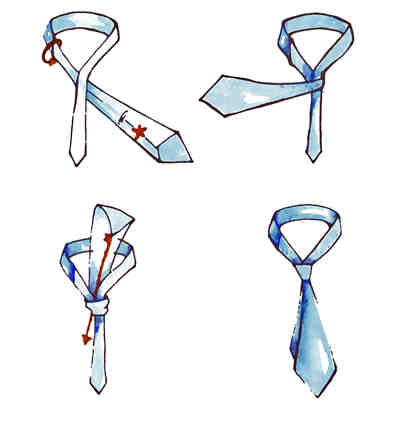Tie guide: history, style tips and how to tie a tie knot
by Andrea Buonamore
Origin of the tie
Croatians claim that the tie was their invention, during the Thirty Years War (1618 - 1648). Croatia even has a day dedicated to the tie, the 8th of October. To understand that this idea of theirs is not correct, it is enough to consult a book by Cesare Vecellio published in 1590, to find the word "tie." And even before Vecellio, Eustache Deschamps (1346-1406) titled a ballad "re-tie the tie."
Also contributing to the widespread use of ties was a brief glacial period that hit Europe from 1645 to 1715. In these years, temperatures dropped and this made the use of such an accessory indispensable. Ties were used as a sort of embroidered bandana, and became a great fortune of the Maritime Republic of Venice, which exported a large number of them at very high prices. The Sun King was a great collector of these precious handkerchiefs. The cheapest models were produced in India, with Great Britain that even decided to pass a law to curb their smuggling and tax them.
Instead, the modern tie was born in England around 1850, in Macclefied, a big industrial center specialized in silk printing, but it was short and wider than the current ones.
Types of tie
The Classic tie has a width of 8 cm and is the tie by definition, essential for the daily outfit of all elegant men.
The Young model is more casual, with a width of 4.5 cm. It is ideal for informal occasions on Saturday evening.
The Unlined version has a width of 6 cm. It is suitable for those who like to be elegant and comfortable at the same time.
The Knitted model is plain and with a square end, a solution for sporty jackets in summer.
Finally, there is the Seven folds version. 8 cm wide, it is made by folding a single flap of fabric three times on one side and four times on the other.
The tie knot
Have you chosen your ideal tie? Now you're ready to tie the perfect knot. The type of knot depends on the material and composition of the tie. In fact, the tie can be knotted in as many as 85 different ways. For the office two are ideal, the simple Windsor or the double Windsor. On the size of the knot, there are two opposing ideas: there are those who think that the knot should be quite loose, and those who prefer it well pulled. The important thing is that in both cases the knot covers the first button of the shirt. Thus, the tie must reach the waistband of the pants.

10 knots for the tie: how to make them
Below is a guide on how to make 10 tie knots. You'll find easy instructions for executing the knot the right way, and practical style tips.
1. Windsor Knot (or Double Windsor)
The Windsor is a triangular knot, perfect for shirts with French or open collars. It is suitable for formal occasions and should be tied with elegant, not thick ties. It is recommended for the Windsor knot to choose a long tie or to wear an elegant vest.
How to tie a Windsor knot.
All the steps to tie a Windsor knot

2. Half Windsor Knot
The Half Windsor knot is similar to the Windsor knot, but is less thick and easier to tie. It is a perfect knot to use every day, and should be worn with an open neck shirt.
How to tie the Half Windsor Knot

3. Simple Knot
The Simple knot is the most famous and used of the tie knots, because of its ease. Suitable for virtually all ties and shirt necks, it is tight with fine ties and wider with thick ones. It has an elongated and symmetrical appearance.
How to tie a simple knot

4. Small Knot
The Small knot is ideal for shirts with narrow collars and very thick ties. It is a very simple knot to tie, but if not done well you risk wasting the tie.
How to tie the small knot

5. Atlantic Knot
The Atlantic knot was very fashionable in the early 1900s. It is a tie knot suitable for casual occasions such as an aperitif or an informal party. It is a knot that is advisable to use with a smart sports jacket, accompanied by a shirt with a wide collar. It is not recommended to use it at work or for any kind of formal event.
Given the considerable number of steps, it is not a knot for beginners and is not particularly functional for everyday life.
How to tie the Atlantic knot

6. Double Knot (or Simple Double or Prince Albert)
Perfect for everyday, the double or Prince Albert knot is easy to make and very elegant. It is very similar to the simple knot, but you have to make an extra turn. This knot fits any shirt collar and can be made with any type of tie, except very thick ones.
How to tie the Double Knot

7. Balthus Knot
The balthus knot is among the largest tie knots, even larger than the Windsor, and if done correctly it has a conical shape. Due to the large number of steps required to complete it, a rather long tie should be used. This is a very extravagant knot, to be used for non professional situations, matched to shirts with open collar and very simple and discreet suits. It is a perfect knot for theatrical and artistic events.
How to tie the Balthus knot

8. Onassis Knot
This knot owes its name to Aristotle Onassis, who created it in the 60s, making it a distinctive feature of his elegant and sophisticated style. Chic and very simple to make, this knot is similar to the Simple knot with the difference that at the end the wide part of the tie is left free, with an effect similar to a scarf. The Onassis knot is perfect for
wide ties to be worn over suits and vests.
How to tie the Onassis knot

9. Pratt (or Pratt Shelby) Knot
This tie knot is very popular in the United States, less so in Europe. The Pratt knot was invented by Jerry Pratt, an American presenter after whom it was named in the 1980s. It is similar to the Windsor knot, only narrower, and is perfect with open neck shirts. The tie you choose should be neither too thick nor too thin. A tip to execute it at its best is to start with the tie backwards, that is, with the seams facing forward.
How to tie the Pratt knot

10. Kelvin Knot
The Kelvin tie knot is named after Lord Kelvin, a 19th century scientist famous for his contribution to the mathematical theory of knots.
The Kelvin knot is perfect with short and very thick ties. In fact, if it is used with a light and narrow tie, it can make the wearer's face look disproportionate.
How to tie the Kelvin knot

Style tips
The choice of tie is as important and strategic as ever for a man. In fact, knowing how to select the tie, among the many proposals on the market and the different styles is not always an easy task. However, there are a few important rules to follow.
For example, it is always important to pay attention that the tie does not have the same color as the shirt. The tie must have a darker tone than the color of the shirt and more intense than that of the jacket.
In addition, the style must be harmonious in colors and patterns: avoid too bright colors and solid colors in the office, always choose refined geometric designs and small, avoid striped ties with a pinstripe suit or plaid shirts. Finally, light colors are more appropriate during the day, while dark colors are better for the evening.
Conclusion
With this guide we hope to have managed to help you with the choice of the ideal tie. Now you can match it to your favorite outfit in the best possible way, choosing the perfect knot for the occasion. Remember that every style lends itself to a different occasion, there are outfits for leisure and some for formal occasions. But the most important thing is that you always feel comfortable. Now that you're ready, don't waste time: choose a dreamy look!
If you want to develop your tie collection, we suggest you to visit Italian Artisan, where you can find the clothing manufacturers for your needs.
Shop the article





